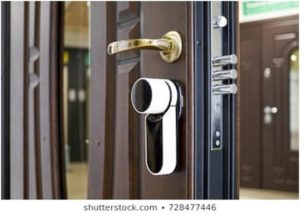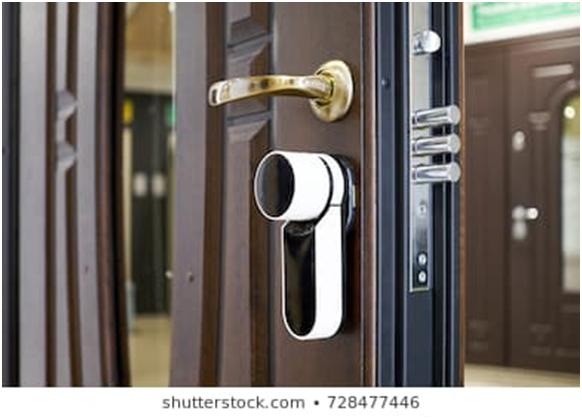The prospect of a keyless life was the reason you opted for a keyless lock. Now, only a few months after installation, your Yale lock keypad is not working and you are wondering if the traditional lock and key were so bad after all.
I have been selling Yale locks for several months now. The bulk of post-sale complaints I receive are when Yale lock keypads are not working. I need to understand what causes lock keypads to malfunction and how to solve this problem.
Image courtesy of Pixabay

The fact that you do not have to keep keys to lock and unlock your door is the most attractive feature of modern keyless locks. A preset, 4 to 8 digit code entered onto the keypad automatically locks and unlocks the door.
How to Use a Lock Keypad
Basic operation of the lock using the keypad requires you to:
- Touch the keypad with the palm of your hand to activate the lock.
- Enter the correct user code on the keypad and then press the (#) key.
Although most locks come with a set of keys, it is expected that these are used when there is a problem with the keypad. Here are a few reasons your Yale lock keypad is not working.
Misaligned Strike Plate
When the deadbolt and strike plate are out of alignment, the deadbolt strikes on the frame of the door when the door is locked, rather than extend fully into its keep. Even when a correct code is entered using the keypad, the lock remains unlocked.
This kind of misalignment can happen even if the lock was installed perfectly initially. Over time, the door and frame can shift because of extreme weather. This can cause enough misalignment to prevent the deadbolt from extending into the hole in the frame.
To correct this:
- First establish the exact spot the deadbolt strikes when the door is locked. Tape a white piece of paper over the strike plate.
- Apply some lipstick on the deadbolt when it is in an extended position then retract it using the thumbnail.
- Push the door to a completely shut position then attempt to lock the door using the thumb nail. The lipstick on the deadbolt leaves a mark on the paper, indicating exactly where the deadbolt hits the strike plate.
- Use this mark to draw an outline on the strike plate. If the difference is less than an eighth of an inch, use a file to enlarge the hole on the door frame to allow the deadbolt extend fully into it.
Dying or Dead Batteries
If the batteries are very low but not completely drained, the keypad may come on briefly then go off before you have entered all the digits of your code. When battery power is completely drained, the keypad does not respond to touch. Even when you touch the screen with the palm or back of your hand to activate it, it remains off. All Yale locks give a low battery alert well before they get completely drained. If you also use a mobile application to operate the lock, you should have received a similar alert through the application well before they are completely drained.
When batteries are completely drained, attach a 9V battery to the emergency power slot on the lock to power up the lock. This will enable you to activate the keypad and enter your code to unlock the door.
A Jammed Deadbolt
When the deadbolt is faulty, it may stop responding to signals from the keypad. A jammed deadbolt remains in a locked position even when a correct code is entered to unlock the door. If you are inside the house, use the thumbnail to unlock the door. When it is open, turn the thumbnail to extend the deadbolt, then retract it several times.
With the door open, turn the thumbnail to get the deadbolt into an extended position. Clean it thoroughly, then spray a graphite lubricant like WD-40 on it. From the inside of the house, close the door and attempt to lock it using the keypad. Be sure to stay on the inside of the house when you close the door to retry the keypad. This way you can always use the thumbnail if the keypad still fails to unlock the lock.
Conclusion
A malfunctioning lock keypad can be extremely frustrating. Fortunately, some Yale locks come with a set of keys which can be used when the Yale lock keypad is not working properly. Keypad malfunctioning has little to do with the age of the lock. Even if your lock is fairly new, keep a key in a safe place outside your house. Have a key in your car, in the garage or with a trusted friend who lives nearby. This way you can unlock the door from the outside even when the lock keypad malfunctions.
FAQ
Is it normal that I can’t use my lock keypad with gloves on?
Yes. When you are wearing gloves, you may need to press harder on the keypad. If your gloves are very thick, you may not be able to use the keypad at all. If you experience this, simply take off the gloves and use the keypad barehanded.
I use my Yale lock keypad as I do my phone, but I often have to repeat my entry a few times before the door unlocks.
Yale lock keypads require you to press hard on the keys. You need to use more pressure than you would use when operating your phone.
How does lubricating a jammed deadbolt help to resolve the problem?
The deadbolt may have developed a layer of rust, which causes friction when the deadbolt moves. Lubrication helps to reduce friction.
The deadbolt and strike plate of my Yale lock are so misaligned, filing the edges of the hole does not help at all.
If the deadbolt and strike plate are totally misaligned, remove and reposition the strike plate appropriately.

